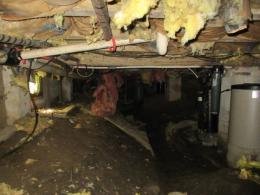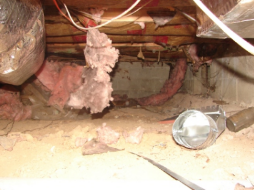Crawlspaces are found quite commonly in South Central PA homes. While they typically go ignored by homeowners who have seemingly more important problems to deal with, crawlspaces can cause a great deal of problems that most people are unfamiliar with. You may not even realize it, but there's a chance that your crawlspace is costing you money and negatively affecting your indoor air quality.
Fortunately, all hope is not lost. The answer can be found in encapsulating your crawlspace, and Energy Smart Home Improvement is highly capable of handling the job from start to finish.
Is your crawlspace costing you money
and making your indoor air dirty? Encapsulate it!

While originally installed with the best of intentions, crawlspaces aren't usually the most hospitable parts of the home environment. They tend to be dirty, moldy and filled with dust and debris that has just been sitting there, floating around since the home was built. Your crawlspace may be out of sight, but that doesn't mean that the nasty stuff inside it can't make its way into the home. These areas can also be susceptible to moisture infiltration from the outside, which can cause humidity issues and mildew.
These contaminants can quite easily enter the living spaces of your home and be dispersed via ductwork. The problem, unfortunately, will only get worse over time as the crawlspace continues to get more and more dirty. Encapsulating the crawlspace is the solution to the problem.
Let Energy Smart Home Improvement install your crawlspace vapor barrier
At Energy Smart Home Improvement, our team of building science experts understands the finer points of installing a crawlspace vapor barrier. We can help to ensure that your crawlspace is clean and dry, which can play a major role in improving indoor air quality within your home, preventing humidity problems and ensuring that you're not losing any energy through your crawlspace. No matter how large or small your crawlspace, we'll come up with a solution that will truly fit your needs.
Signs of problems in your crawlspace

- Cold floors in areas of home above the crawlspace
- Fiberglass batt insulation has fallen out of place between floor joists in crawlspace
- Musty smells, dampness or visible signs of mold in the crawlspace
- Mice or other pests call your crawlspace their home
Fiberglass batt insulation installed between joists in a crawl space absorbs moisture, loses R-value, and often falls out of place.
Do vented crawlspaces work?
In the past, most building codes required crawlspace vents to aid in the removal of moisture. Today, building scientists realize an unvented or conditioned crawlspace with effective, aligned pressure and thermal boundaries is a far more effective option when using proper moisture control.
What is wrong with vented crawlspaces?
In the summer warm moist air is brought into the crawlspace through foundation vents where it can condense on the cooler crawlspace surfaces. Joists and wood subfloors are an ideal breeding ground for mold when damp. This can lead to structural damage and costly repairs. Termites and carpenter ants are attracted to damp environments where moist wood is present.
In the winter cold air enters the building envelope through crawlspace vents creating cold floors, cold rooms and high energy bills. Mice and other pests are attracted to this environment.
How do I create a healthy comfortable home?
The first step to creating a functional, efficient crawlspace is to seal it. A vapor barrier is installed atop the dirt or stone floor to prevent excess moisture and condensation from accumulating in the crawlspace. All seams and edges of the vapor barrier must be sealed using seam tape and spray foam as even small areas left open can allow significant volumes of moisture. At Energy Smart we use a 45 mil reinforced liner more than twice the thickness of our competitors!) to ensure durability and long term performance. Next, foundation vents are sealed to create an effective pressure boundary. The last step in air sealing a crawlspace is to spray foam the gaps at the band board detail (the wood framing just above the foundation).
Next we need to align the pressure and thermal boundaries by installing rigid insulation to the foundation walls. This prevents the conduction of cold temperatures through the block or concrete into the crawlspace.
Our very important final step is to perform a blower door test as a means of inspecting our work for any remaining air infiltration as well as to measurement the overall reduction in air infiltration.

